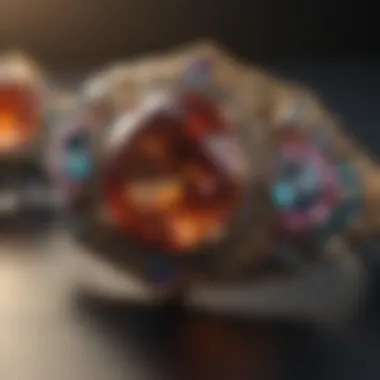Comprehensive Gemstone Buying Guide for Enthusiasts


Intro
Gemstones are more than mere decorations; they are manifestations of natural history and human artistry. For both novice buyers and seasoned collectors, the journey to acquire gemstones can be intricate. Understanding the nuances of different types of gems, their unique qualities, and the market dynamics is essential. This guide intends to illuminate significant aspects of gemstone purchasing. Insightfully, it will provide a roadmap that outlines the selection process, the critical characteristics to consider, and essential care practices.
Gemstone Overview
Description of the Gemstone
Gemstones are minerals or rocks that, when cut and polished, are used in jewelry or for adornment. Each gemstone possesses individual character and aesthetics. For instance, diamonds are celebrated for their hardness and brilliance, while emeralds are cherished for their lush green hues. The allure of gemstones often derives from their uniqueness—no two stones are precisely alike. Natural gemstones form through geological processes, while synthetic or lab-created gems are manufactured to replicate these natural forms.
Physical Properties
Gemstones exhibit a variety of physical properties that help in identifying and evaluating them. Key characteristics include:
- Hardness: Measured by the Mohs scale, hardness indicates a gem's resistance to scratching. For example, diamonds rank highest at 10.
- Cleavage: This refers to the tendency of a mineral to break along specific planes, affecting how a gem can be cut.
- Luster: This describes how light interacts with a gem's surface, contributing to its visual appeal.
- Color: Color is often the first thing noticed about a gemstone and can vary widely even within the same type.
- Transparency: Some gemstones are transparent, while others are opaque. This property significantly influences a stone’s desirability and value.
"Understanding the physical properties of gemstones significantly aids in making informed purchasing decisions."
Healing Properties
Metaphysical Attributes
Many people believe that gemstones carry metaphysical properties and can influence emotional and spiritual well-being. Various cultures associate specific stones with particular healing attributes. For instance, amethyst is often linked to tranquility and stress relief. Similarly, citrine is viewed as a stone of abundance and motivation. It is essential to approach these attributes with an open mind while remembering that personal experience plays a significant role in perception.
Common Uses in Holistic Practices
- Meditation: Gemstones are frequently used to enhance meditation practices. Holding a stone while meditating can help focus energy and aid in relaxation.
- Chakra Balancing: In holistic practices, different stones are believed to correspond with the body's chakra points, promoting balance and emotional stability.
- Healing Crystals: Many people incorporate crystals into their healing routines, often using them to encourage positive energy flow within their lives.
This guide will delve deeper into specifics about purchasing, maintaining, and appreciating gemstones, thus enriching the knowledge for enthusiasts and collectors alike.
Preamble to Gemstones
Gemstones have fascinated humanity for centuries. The beauty and rarity of these natural stones make them highly sought after for jewelry and decor. In addition, they hold sentimental value, often serving as symbols for love, status, or achievements. Understanding gemstones is crucial for anyone interested in purchasing them, whether for personal use or investment purposes.
The significance of this section lies in its ability to provide clarity on the types of gemstones available and their essential qualities. Knowing the basics prepares buyers to navigate the complexities of the market. This understanding also fosters informed decisions, ensuring that the purchases made are both valuable and meaningful.
Definition and Importance
A gemstone is a precious or semiprecious mineral, which, after being cut and polished, is used mainly in jewelry. Gemstones are admired for their beauty and are often associated with various cultural meanings and properties. Their importance is not merely aesthetic; they can be significant investments that appreciate over time, depending on quality and rarity.
Gemstone Categories
Gemstones fall into two main categories: precious stones and semiprecious stones. Understanding the distinctions between these types helps buyers make informed decisions based on their needs and budget.
Precious Stones
Precious stones include widely recognized gems such as diamonds, rubies, sapphires, and emeralds. The primary characteristic defining these stones is their exceptional rarity and durability. Their popularity stems from both their stunning beauty and their perceived value in the market.
Diamonds, for instance, are celebrated not only for their brilliance but also for their reputed symbolism of eternal love. The high value of precious stones lies in their scarcity, with many being found only in specific geographic locations. Investing in these stones can offer substantial returns due to their historical significance and demand. However, their cost can be prohibitive for some buyers.
Semiprecious Stones
Semiprecious stones encompass a wider range of gems, including amethyst, garnet, and turquoise. These stones can be equally beautiful but are generally more abundant and therefore less expensive than precious stones. Their key characteristic is the variety available, which allows for a broader selection while catering to different tastes and budgets.
Stone such as aquamarine are beloved for their vibrant colors and unique designs. The affordability of semiprecious stones makes them accessible to a larger audience, appealing to both casual consumers and serious collectors. However, buyers should remain aware of quality variables, as not all semiprecious stones hold the same value or allure.
Understanding Gemstone Properties
Understanding gemstone properties is crucial for both novice and seasoned gemstone enthusiasts. Individuals should familiarize themselves with the inherent characteristics that define each stone's identity and quality. These properties not only affect the aesthetics but also influence the gem's durability, healing attributes, and cultural significance. Having robust knowledge in this area empowers buyers to make informed decisions when selecting gemstones, thereby ensuring satisfaction with their purchases.
Physical Characteristics


Physical characteristics encompass the tangible attributes that quantify a gemstone's quality and appeal. This includes hardness, luster, and color.
Hardness
Hardness is a vital measure of a gemstone's durability. It is evaluated on the Mohs scale, which ranks minerals from 1 (softest) to 10 (hardest). For example, diamond ranks a 10, while talc is a 1. A high hardness rating implies a gemstone is less prone to scratching and damage, making it a desirable choice for jewelry that is worn regularly.
However, harder stones can be more challenging to cut or shape. This can lead to additional costs and require specialized skills during the crafting process. Ultimately, hardness plays a significant role in the longevity and practicality of a gemstone.
Luster
Luster refers to the way light interacts with the surface of a gemstone. It can range from dull to brilliant and influences how attractive a stone appears. For instance, pearls exhibit a unique luster that is soft and glowing, while sapphires have a vitreous luster that gives them a shiny appearance.
Understanding luster can guide buyers in choosing stones that will shine effectively in different lighting conditions. Good luster often correlates with higher quality, but the aesthetic appeal remains subjective. Each individual's taste can dictate whether a certain level of luster fits their preferences.
Color
Color is perhaps the most visually striking characteristic of gemstones and can drastically affect a stone's value. Color grading involves assessing hue, saturation, and tone. Certain stones, like rubies, are valued more when they have a rich red hue as opposed to pale or washed-out colors.
Gemstones can also possess unique color features, such as color zoning or the phenomenon known as asterism, seen in stones like star sapphires. While vivid colors generally garner more attention, the importance of color can vary based on personal preferences and market demand. Hence, color remains a pivotal factor when evaluating gemstones.
Metaphysical Properties
Metaphysical properties refer to the belief that gemstones can have influences beyond their physical characteristics. Many collectors appreciate these attributes, as they add depth and meaning to their acquisition.
Healing Attributes
Healing attributes of gemstones are rooted in ancient traditions and beliefs. Many people believe that certain stones can promote physical healing or emotional well-being. For example, amethyst is often associated with enhancing calmness and clarity, while citrine is believed to attract prosperity.
These claims may not be scientifically substantiated, yet they carry significance for many individuals who purchase these stones for their perceived benefits. It is important to approach claims of healing with an open mind, but also to rely on established medical practices for serious health concerns.
Symbolism
Symbolism is another core aspect of gemstone appreciation. Various cultures assign specific meanings to different stones. For example, garnet is commonly associated with love and protection, while turquoise symbolizes friendship and healing.
Understanding gemstone symbolism can enhance the personal value of each stone, adding a layer of connection between the wearer and the gem. Individuals might choose gems based on their symbolic meanings, considering what resonates most with their life journey.
Gemstones can serve not only as adornments but as intricate narratives steeped in personal meaning and cultural history.
When exploring gemstone properties, it is crucial to consider both the physical and metaphysical aspects. This comprehensive knowledge can help buyers navigate their choices with confidence and promote a sense of connection to their selected stones.
Setting a Gemstone Budget
Setting a budget for gemstone purchases is crucial for both new buyers and seasoned collectors. A well-defined budget helps to avoid overspending and ensures that your selection aligns with your financial plans. Gemstones can vary significantly in price based on multiple factors. Highlights of these factors include rarity, quality assessment, and market trends. Understanding these elements can help you make informed decisions and reduce the risk of buyer's remorse.
Factors Influencing Price
Rarity
Rarity is one of the most significant aspects when it comes to evaluating gemstones. Rare gemstones tend to command higher prices due to the limited supply. For example, gems like red diamonds or certain types of opals can be scarce in the market. The key characteristic of rarity is its connection to availability. If a gemstone is hard to find, its value increases. When setting your budget, it is important to consider how rarity impacts your choices in gemstones.
Rare stones can be a beneficial consideration if you aim to own something unique. However, this can also lead to overspending. One unique feature of rare gemstones is their price volatility. Prices can fluctuate based on market demand, which can be advantageous or disadvantageous depending on your purchasing strategy.
Quality Assessment
Quality assessment plays a crucial role in determining the price of a gemstone. Factors like cut, clarity, color, and carat weight contribute to the overall quality. Each of these attributes can affect the gemstone's appearance and value. The key characteristic of quality assessment is its emphasis on the gem's visual and structural integrity.
For instance, a well-cut diamond will sparkle more than one that is poorly cut, affecting its desirability and price. Understanding quality assessment is important. It allows buyers to prioritize what is most important to them. Buying a high-quality gem often comes with a higher cost, which is worth keeping in mind when budgeting.
Market Trends
Market trends can greatly influence gemstone prices, often leading to unexpected spikes or drops. Trends can be driven by various factors, including fashion shifts or the influence of social media. The characteristic of market trends is its ever-changing nature, which can sometimes make it challenging for buyers to stay informed.
An example is the rising popularity of certain colored gemstones, which may see a sudden surge in price if demand increases. Understanding current market trends allows you to make more strategic purchases. However, relying too heavily on trends without proper research can result in poor investment choices.


Budgeting Techniques
Setting up effective budgeting techniques for purchasing gemstones can greatly enhance your buying experience. Here are some practical tips to consider:
- Do Research: Understand the average prices of the specific gemstones you are interested in.
- Create a Priority List: Decide which factors matter most to you, such as rarity, quality, or brand reputation.
- Set a Range: Establish a minimum and maximum price to guide your selection. This helps to maintain flexibility while keeping you grounded.
- Adjust for Quality: Be ready to adjust your budget if you find a gemstone that meets your ideal quality assessments.
"Research is key. The more you understand, the better your purchasing decisions will be."
By applying these techniques, you can ensure a more prudent and satisfying shopping experience for your gemstones.
Best Practices for Purchasing Gemstones
Purchasing gemstones can be both exciting and daunting. Understanding best practices is essential for ensuring a wise investment. Knowing where to buy and how to research is crucial in making informed decisions. This section elaborates on these aspects, helping you navigate the complexities of the gemstone market effectively.
Where to Buy
Online Marketplaces
Online marketplaces have gained immense popularity for buying gemstones. They offer a wide selection, often featuring unique stones not found in local stores. One key characteristic of these platforms is their ability to provide customer reviews and ratings. This feature allows buyers to assess the quality and credibility of the sellers easily.
Buying online can be beneficial; however, potential drawbacks exist. The main disadvantage is the inability to inspect the gemstone physically before purchase. Customers must rely on images and descriptions provided. Thus, it is vital to choose reputable online platforms like eBay or Etsy for enhanced reliability.
Local Retailers
Local retailers present a different buying experience. Visiting a store allows customers to examine gemstones in person. The tactile experience can enhance purchasing confidence. Additionally, local retailers often have knowledgeable staff who can provide insights about the gemstones. This personal interaction offers transparency in the buying process, making it more appealing for new buyers.
However, local retailers may have a limited selection compared to online platforms. Higher prices can also be a concern due to overhead costs. Buyers should weigh these factors before deciding.
Gem Shows
Gem shows serve as a unique venue for buying gemstones. These events offer a variety of vendors, allowing consumers to compare stones side by side. Attendees can find rare and high-quality gemstones often exclusive to these shows. The ambiance encourages networking, enabling enthusiasts to meet experts and other collectors.
Nevertheless, gem shows can be overwhelming due to the sheer volume of options. It is easy to feel lost among numerous displays and sellers. Potential buyers should prepare by researching the event and targeted vendors beforehand to increase their effectiveness and enjoyment.
Research Considerations
Effective research is essential for gemstone purchasing decisions. An informed buyer is less likely to make costly mistakes. Here, we examine significant research aspects that can enhance the buying experience.
Gemstone Reviews
Gemstone reviews provide critical insights into the quality of gemstones and the credibility of sellers. Reviews help buyers understand how stones hold up in real-world use and the satisfaction of previous customers. They highlight both strengths and weaknesses of vendors and gemstones alike.
The unique feature of gemstone reviews is their ability to present first-hand experiences from others, offering invaluable guidance. However, not all reviews are reliable. Buyers must critically assess sources and look for patterns in feedback to discern authenticity.
Seller Credentials
Seller credentials are crucial in ensuring a secure purchasing experience. Understanding a seller's background, including their qualifications and experience, establishes trust. A reputable seller usually provides transparency about gemstones, including their origins and any treatments.
The uniqueness of this aspect lies in the peace of mind it grants buyers. Due diligence can prevent fallout from scams or poor quality purchases. Therefore, buyers should seek sellers affiliated with recognized organizations, such as the Gemological Institute of America (GIA), which demonstrates a commitment to quality.
Evaluating Gemstone Authenticity
The authenticity of a gemstone is paramount for any buyer. Understanding its genuine nature ensures that the consumer receives what they pay for. With a market inundated with replicas and synthetics, recognizing true gemstones can be a complicated process. Knowing how to evaluate authenticity allows buyers to make informed decisions, safeguard their investments, and enjoy the full value of their purchases.
Certification Standards
Gemological Institute Certification
Gemological Institute Certification, often referred to as GIA certification, plays a crucial role in establishing the credibility of a gemstone. This certification is recognized worldwide and serves as a hallmark of quality. One key characteristic of GIA certification is its thorough analysis conducted by trained gemologists. This ensures that each gemstone is evaluated for its unique qualities.
The GIA's detailed reports outline crucial aspects such as cut, color, clarity, and carat weight. This level of detail empowers buyers to understand the value of their gemstone in a transparent manner. The GIA certification's popularity stems from its reliability, assuring buyers that their gemstones have been assessed by experts. However, it is important to note that obtaining GIA certification may involve additional costs, which can affect the overall price of the gemstone.
Independent Appraisals


Independent Appraisals offer another avenue for determining gemstone authenticity. These appraisals are performed by certified professionals who are not affiliated with any retailers. An independent appraisal can provide an unbiased evaluation, highlighting the strengths and weaknesses of the gemstone.
One significant advantage of independent appraisals is the personalized approach they offer. Appraisers delve into factors like market conditions and rarity, giving buyers a tailored understanding of their gemstone's worth. However, potential disadvantages include varying qualifications and the possibility of inconsistent appraisals across different professionals.
Signs of Authenticity
Several signs indicate whether a gemstone is authentic. Firstly, examining the gemstone under a jeweler's loupe can reveal natural inclusions. Natural inclusions are evidence of the gemstone's organic formation process and are often absent in synthetic stones.
Another indicator is the gemstone's weight. Real gemstones tend to be heavier than their synthetic counterparts due to their density. In addition to physical properties, a reputable seller's documentation and branding can also attest to a gemstone's authenticity.
Gemstone Care and Maintenance
Gemstone care and maintenance is crucial for preserving the beauty and integrity of these valuable pieces. Understanding how to properly clean and store gemstones can prolong their lifespan and enhance their visual appeal. By implementing systematic care routines, gem enthusiasts can avoid damage and maintain the stones in pristine condition. This section focuses on essential cleaning techniques and optimal storage recommendations to help protect gemstone investments.
Cleaning Techniques
Proper Tools
Proper tools are fundamental for effective gemstone cleaning. Investing in high-quality cleaning tools ensures that stones remain undamaged during the process. Common tools include soft brush, microfiber cloth, and a gentle toothbrush. These tools are acclaimed for their soft bristles, which reduce the risk of scratching delicate surfaces.
Using correct tools helps in getting rid of dirt without causing wear. A unique advantage of these tools is their availability; they can be purchased easily and used at home, making them a popular choice among gemstone collectors. However, one must ensure that tools are designated only for gemstones to avoid cross-contamination.
Cleaning Solutions
Choosing the right cleaning solution is equally important for gemstone care. Effective cleaning solutions include mild soap mixed with water or specialized gemstone cleaners. These solutions are beneficial because they effectively dissolve residues and impurities without harming the stone.
The unique feature of these cleaning solutions is their pH neutrality, ensuring that gemstones do not get damaged while being cleaned. Ensuring that cleaning liquids are free from alcohol and harsh chemicals is vital; otherwise, it may lead to dulling or damage. These cleaning solutions are easy to find Online or in local markets, making them a practical choice for anyone handling gemstones.
Storage Recommendations
Proper storage is imperative for preserving gemstone quality. Gemstones should be stored away from direct sunlight and in a stable environment. Recommended storage includes padded boxes or soft cloth pouches to prevent scratching. It is also wise to store different types of gemstones separately to avoid harder stones damaging softer ones.
When storing, ensure the environment is dry, as moisture can lead to damage or inclusions in certain stones. An additional consideration is the temperature control; extreme changes can lead to cracks or chips.
In summary, gem care and maintenance involve systematic cleaning and careful storage. Following these practices helps to maintain the vibrant appearance and longevity of gemstones, securing their place as cherished articles.
Cultural and Historical Context of Gemstones
Understanding the cultural and historical context of gemstones is crucial when navigating their purchase. It highlights the deep-rooted significance these stones hold across various societies. Many gemstones are not just valued for their beauty but also their rich histories and meanings. By learning about these aspects, buyers can make more informed and meaningful choices.
Historical Significance
Throughout history, gemstones have been used as symbols of power and status. Ancient civilizations, including Egyptians and Greeks, adorned themselves with gemstones to signify wealth and influence. For instance, lapis lazuli was highly prized in ancient Egypt, often associated with the heavens and believed to bring protection and wisdom. Precious stones like diamonds, first discovered in India, traded significantly in the ancient world. They were not only sought after for adornments but also for their supposed mystical properties. In medieval Europe, gemstones adorned crowns and scepters, imbuing rulers with legitimacy and authority.
Furthermore, many gemstones bear tales of patronage, trade, and conquest. The hope diamond, for example, has a notorious history linked to curse and tragedy. Such narratives enrich the intrinsic value of these stones and speak to their historical journey through time.
Global Usage Across Cultures
Gemstones reflect the diversity of beliefs and practices across cultures. For instance, in Indian culture, sapphires and rubies are believed to bring wealth and prosperity. In contrast, turquoise holds significance in Native American culture, symbolizing protection and healing. The use of gemstones in rituals, art, and jewelry demonstrates their omnipresence in human civilization.
Additionally, gemstones often play a role in significant life events. Engagement rings featuring emeralds or sapphires are increasingly popular due to their perceived meanings. In many cultures, gemstones serve as tokens of love, remembrance, or commitment, shaping how individuals express emotions.
In summary, the cultural and historical context of gemstones spans millennia, reflecting diverse beliefs and traditions. As such, understanding these facets enhances one’s appreciation when selecting a gemstone, providing personal meaning beyond mere aesthetics.
"Historically, gemstones have woven into the fabric of human culture, shaping our symbols of power, love, and resilience."
The End
The conclusion of this comprehensive guide plays a pivotal role in summarizing the essential takeaways regarding gemstone purchasing and maintenance. It consolidates the information presented across the various sections, thereby reinforcing key concepts and insights.
Understanding gemstone buying is not just about acquiring beautiful pieces; it is an investment of time and resources. Recognizing the significant factors—such as authenticity, cultural context, and proper care—enhances the overall experience and satisfaction with one’s collection.
Here are a few considerations that emphasize the importance of this topic:
- Knowledge is Power: As seen in earlier sections, informed choices lead to better purchases. By understanding gemstone properties and market dynamics, buyers can avoid pitfalls and choose wisely.
- Cultural Significance: Gemstones have rich histories connected to different cultures. Acknowledging this context not only adds value to the collection but also encourages appreciation of the craftsmanship and heritage behind each piece.
- Proper Care: Adequate maintenance is essential for preserving beauty and value. With defined care practices, jewelers and collectors can ensure their gemstones remain vibrant and cherished across generations.
In concluding this narrative, readers are encouraged to reflect on their journey of gemstone selection. Whether they are collectors or simply enthusiasts, the insights gained from this guide establish a foundational understanding that fosters thoughtful engagement with the gemstone market. The right choice transcends aesthetics; it becomes a blend of knowledge, culture, and personal connection that enriches the collector’s passion.
"A gemstone is not merely a part of jewelry; it embodies stories, heritage, and an intricate world of art."
In this realm, continual learning is invaluable. Each gemstone possesses its unique tale, waiting to be discovered and appreciated by its beholder.







